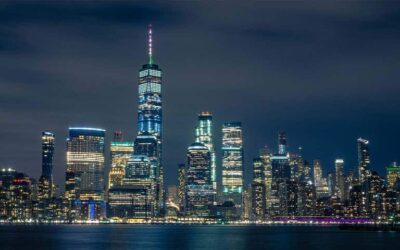Commercial lighting control systems give business owners a diverse set of options that help them operate their lights. In short, quality commercial lighting controls are designed to provide the right lighting exactly where it is needed. The benefits of this include energy efficiency, responsible power consumption, increased safety and security, responsive controls and much more. However, as with anything, it is important that your system utilizes commercial lighting control strategies that fit your specific needs.
Commercial Lighting Control Strategies Overview
In the most basic sense, commercial lighting controls provide two outputs: switching lights on and off or dimming them. They base this output on the inputs received and the requirements programmed into the control device. For example, you may want lights dimmed based on large quantities of ambient lighting to ensure spaces are adequately lit without having to waste additional power on overhead Light Emitting Diodes (LEDs). However, dimming and switching are not the only commercial lighting control strategies that can be used. Other strategies include, but are not limited to:
Zoned Lighting
Zoned lighting is best when different areas have differing light requirements. For example, a large office area that supports cubicles will likely require a different type of lighting than a warehouse would. Similarly, a conference room that supports intermittent meetings has lighting requirements that are separate from that of offices that are used throughout the working day. Zoned lighting strategies help to ensure these varying requirements are managed efficiently and accurately, providing the necessary light when needed.
Occupancy Sensors
The US Department of Energy (DOE) estimates that 40% of your power bill is spent on lighting; 30% of this is typically spent lighting spaces that are unoccupied. In other words, the DOE estimates that roughly 30% of the money you spend on your lighting power expenditures is wasted. Occupancy sensors, which often utilize motion detectors or Radio Frequency Identification (RFID) scanners, can switch or dim lights depending on whether the space is occupied. When paired with an automated commercial lighting control system, this can save you hundreds on your electric bills while still ensuring occupied areas remain illuminated.
Daylight Harvesting
Daylight harvesting provides another important function that can help to reduce costs. Ambient light, the natural light that streams through windows, can be used to help supplement your overhead LED lighting. Daylight harvesting sensors can automatically detect ambient light levels and adjust your lights accordingly, often through dimming functions. Not only can this decrease your energy costs, but it can also be better for your employees’ eye health and morale.
Auto-Scheduling
Many commercial establishments have set office hours. Auto-scheduling allows users to schedule lights based on these hours. While this may not be ideal for all commercial buildings, auto-scheduling helps to ensure lights follow an automated sequence and remain powered only when required.
If your organization is considering a Lighting Control System, knowing the key benefits could be key to c-suite buy-in. Read our second article in our Lighting Control System series, The Benefits of Intelligent Lighting Controls in Commercial Buildings.
Interior Lighting Control Strategies
Now that you understand a bit more about various commercial lighting control strategies, it is important to look at how these independent strategies can be combined to help enhance your lighting needs while reducing overall energy costs. Interior lighting control strategies are typically the first to be addressed. Let’s take a look at how different control strategies can be applied to various interior areas of a commercial space.
Corporate Offices
Corporate offices may have “standard” hours, however, employees are often there before and after this allotted timeframe. Given the work being performed, the odd hours being worked, and the various spaces that make an office work – there are plenty of ways interior lighting control strategies can help to enhance these spaces. Zoned lighting, paired with daylight harvesting sensors, can ensure spaces are receiving the light they need without wasting energy on additional LED lighting. For example, ambient light steaming into an area that is home to cubicles requires a certain level of lighting. This not only helps computer screens to read more easily, it protects your employees’ eyes from unnecessary strain. However, pairing this zone with a daylight sensor, the overhead lights can automatically adjust or dim based on the level of external light entering the room. Bathrooms in an office building are one of the more infrequently occupied spaces. Unlike the office or cubicle area, bathrooms have occasional occupants. Pairing zoned lighting with an occupancy sensor can ensure lighting is only on when someone is using the facility instead of remaining on all day.
Restaurants
Restaurants often strive to create a specific atmosphere for their patrons. The lunch rush, for example, may be an event catered towards business meals. For example, a team-building exercise may mean 12 co-workers opt to enjoy a meal together to discuss pressing issues or simply get to know each other better. This may call for full lighting. However, the evening sessions may cater more towards a romantic environment. Daylight sensors may be used to detect the decreasing ambient light and dim lights according to your settings to ensure this atmosphere remains throughout the night. At the same time, the kitchen and bathrooms will need to operate under zoned lighting to ensure they are fully illuminated at all times. Auto-scheduling may also be of convenience since the majority of restaurants do not remain open for 24-hours.
Retail Stores
Retail stores typically operate during specific hours. As such, the auto-scheduling feature may be ideal. Most retail spaces should remain illuminated, whether occupied or not, to ensure potential customers know the space is open for business. That makes an occupancy sensor a waste here. However, daylight harvesting can again save a retail store money if they have large windows as lights can automatically adjust to meet with lighting requirements.
Exterior Lighting Control Strategies
Exterior lighting control strategies should be developed with a full understanding of the commercial site, and its intended purpose. Some examples of appropriately used exterior lighting control strategies include:
Sports Arena
Sports arenas are often used both day and night. For those that are outdoors, there are several different strategies that can enhance these spaces. First, evening sporting events must be fully illuminated. A dimming function is not needed here. However, a daylight harvesting sensor can ensure these lights power on once ambient light levels dip to a certain point. Additionally, most sporting events are played during a certain time. By auto-scheduling the maximum amount of time a game may be played, including overtime, you can ensure the lights do not remain on after the event has ended.
Industrial Lots
Industrial lights operate under a different concept. Expensive equipment is often parked in these lots while not in use. For many companies that utilize industrial equipment, there are standard working hours. This means that it is unlikely that the lot needs to be fully illuminated after the day has ended. Zoned lighting can ensure that some of the lights do remain on to provide enough illumination for security cameras or personnel to quickly identify an issue. A daylight harvesting sensor may help to ensure the zoned lighting feature knows when to turn off all but the essential lighting once the day has ended. For increased safety, however, the addition of a motion sensor can ensure that any potential thieves are quickly illuminated should they pass within the boundaries of the light. This is a proven deterrent when it comes to theft and vandalism.
When considering an industrial lighting solution, lighting controls are just one part of the equation. For a full review of the options, we suggest reading: Your Options for an Industrial LED Lighting Solution.
Parking Lots & Sidewalks
Parking lots and sidewalks should be illuminated for safety reasons. A lone individual walking to their car after hours in a dark parking lot can leave them vulnerable to criminal intentions. Auto-scheduling zoned lighting to turn on at a certain time can help increase safety and decrease criminal activity.
Lighting Strategies with Action Services Group
Our experts here at Action Services Group understand that commercial lighting control strategies should be tailored to the specific needs of each company. If you would like to learn more about our interior or exterior lighting control strategies, contact Action Services Group by calling 610-558-9773, email [email protected] or schedule a call.







































Great content! Super high-quality! Keep it up! 🙂